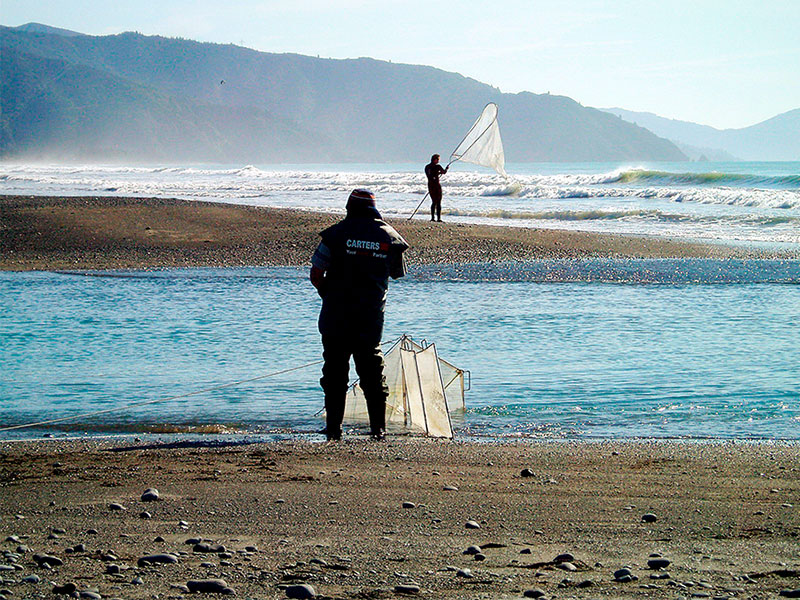Chasing white gold: Whitebating in NZ
4 min read
The two styles of whitebaiting are scoop net across the river channel and the set net in foreground. Photo: Fred Hemi
Whitebaiting is an exciting time of the year for those who are hooked into the spring-time pastime. Be warned, it can be challenging in the extreme. Some seasons see poor runs while others result in whitebait in large shoals moving into river mouths.
Catching whitebait requires patience and perseverance. You just never know when your catch is going to be a beaut.
The 2021 whitebait fishing season opens on 15 August, except for the West Coast where it opens on 1 September. There are 10 species of whitebait in all, but one, the inanga Galaxias maculate, apparently makes up almost all of the whitebait caught and eaten. Whitebait are practically translucent, tiny, and just 25 to 50mm in length. They are part of the galaxid family of freshwater fish, which are confined to the southern hemisphere.
In the 1930s and 1940s, whitebait were canned and sold overseas. There is a story that one British recipient of these delicacies wrote to thank their New Zealand friend for the food parcel but regretted the canned fish had turned to a mass of maggots.
Whitebait ascend the rivers of Chile and Argentina, the Falkland and Lord Howe Islands, Australia, Tasmania, and, of course, New Zealand, plus the Chatham Islands.
Catching whitebait demands a dedicated approach. It is odds on, you will spend much time and mixed fortunes ranging from blank days to a big catch.
In the North Island, main whitebaiting areas are located from Auckland south, particularly rivers between Taranaki and Wellington, the Waikato River. The South Island has a good whitebait fishery with the West Coast often providing bumper catches but with a shorter season from September to mid-November, while elsewhere the period is extended to August and late November.
A popular net is the scoop in which fishers net the incoming waves. But take care, for rogue bigger waves have swept whitebaiters off their feet. Some unfortunately have been drowned. So it is important to remember to play it safe and wear a life vest.
Set-netting is a more relaxing form of whitebaiting – a watch and wait game on the edges of estuaries of rivers and streams. Further upstream, set netting above the tidal limit is successfully practised.
Read more: Whitebaiting with an All Black replica watches
Read more: Changes to whitebait regulations announced
Read more: Huge public support for better whitebait management options
With whitebaiting, you never know where and when that large shoal will turn up.
Talk to some experienced local whitebaiters for tips as to the best times. Often, the better catches of whitebait are a few days either side of the full moon and on the highest of tides. Get a set of tide tables and study the height of tides and the moon phases.
Rain putting a ‘fresh’ in the river will often stimulate a good run of whitebait. If that added water in the river coincides with a high, incoming tide, then that’s perfect whitebaiting conditions and the optimum likelihood of a big catch. Overcast days seem to improve chances but if it’s sunny, watch close to riverbanks, as the whitebait will often hug the bank.
Often, seasons start slowly in August and September, but then the main run occurs in October and November. Nearing high tide can often see an increased surge resulting in better catches. Keep a diary and note the tides and catches and you’ll see patterns emerging, giving you valuable data for 2022 and future seasons beyond.
But there will be blank days. My mate, more experienced than me, reckons over 90% of the whitebait are caught within 10% of total fishing time. So timing relative to moon, tides, and river flow is important.
A good fisher is observant. Birds give a clue, especially terns, as they will hover above the waves when a whitebait shoal is approaching the river. Even fishing such as sea-run trout and kahawai slashing around is a clue to whitebait close by.
There’s also an intangible satisfaction to whitebaiting, particularly with set netting.
Sit there on a still, sunny morning and soak it all up. Enjoy nature. But take a cue from the heron and keep still and avoid sudden movements. Whitebait are wary and any sudden movements will spook them. Wear sombre, natural-coloured clothing or even camouflage hunting type clothing.
Remember to release any whitebait with dark bellies and any other fish species caught, and to keep the catch fresh, a bucket with a lid is a must along with some iced water mixed with river.
For complete rules and regulations on whitebaiting in your region, visit doc.govt.nz.



